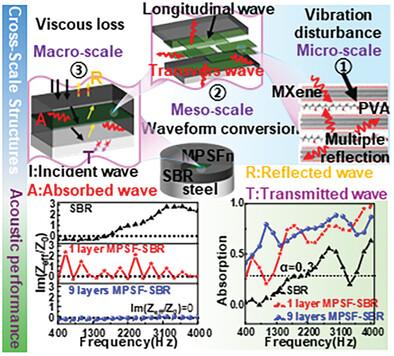Ti3C2Tx-Based Cross-Scale Laminated Structural Structures: Enabling Sub-Wavelength Impedance Modulation and Underwater Broadband Sound Absorption
IF 13
2区 材料科学
Q1 CHEMISTRY, MULTIDISCIPLINARY
引用次数: 0
Abstract
Designing underwater acoustic absorbing materials with sub-wavelength thickness in the mid-to-low frequency range (400–4000 Hz) remains a challenge, especially for broad frequency applications. Most current designs focus on a single spatial scale, limiting their frequency range. To address this, a composite material (MPSFn-SBR) made of Ti3C2Tx-polyvinyl alcohol self-assembled films(MPSFn) and styrene-butadiene rubber (SBR) is designed, featuring a cross-scale laminated structure. On a macroscopic scale, the MPSFn-SBR has a sandwich structure, with the SBR layer serving as a protective layer and the MPSFn core modulating impedance. On a mesoscopic scale, the MPSFn layers transform longitudinal waves into shear waves, improving sound absorptionat mid-to-low frequency range. On a microscopic scale, the MPSFn's two-phase coexistence system with a defect phase enriches vibration modes, broadening the absorption bandwidth. Results demonstrate that the cross-scale laminated structure enables effective sound absorption at sub-wavelength thickness (10 mm, ≈1/375 of the wavelength). A broad peak is observed from 1200 to 4000 Hz, with an average absorption coefficient of 0.91. The maximum absorption in the 400–1200 Hz range is 0.7. This study expands the design perspective of underwater sound-absorbing materials, transitioning from a single spatial scale to a comprehensive strategy, fostering innovation and development in the field.

求助全文
约1分钟内获得全文
求助全文
来源期刊

Small
工程技术-材料科学:综合
CiteScore
17.70
自引率
3.80%
发文量
1830
审稿时长
2.1 months
期刊介绍:
Small serves as an exceptional platform for both experimental and theoretical studies in fundamental and applied interdisciplinary research at the nano- and microscale. The journal offers a compelling mix of peer-reviewed Research Articles, Reviews, Perspectives, and Comments.
With a remarkable 2022 Journal Impact Factor of 13.3 (Journal Citation Reports from Clarivate Analytics, 2023), Small remains among the top multidisciplinary journals, covering a wide range of topics at the interface of materials science, chemistry, physics, engineering, medicine, and biology.
Small's readership includes biochemists, biologists, biomedical scientists, chemists, engineers, information technologists, materials scientists, physicists, and theoreticians alike.
 求助内容:
求助内容: 应助结果提醒方式:
应助结果提醒方式:


